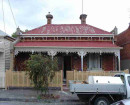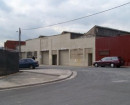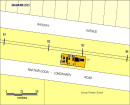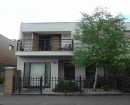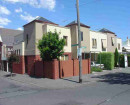FORWARD SURGE
100 ST KILDA ROAD SOUTHBANK, MELBOURNE CITY
-
Add to tour
You must log in to do that.
-
Share
-
Shortlist place
You must log in to do that.
- Download report




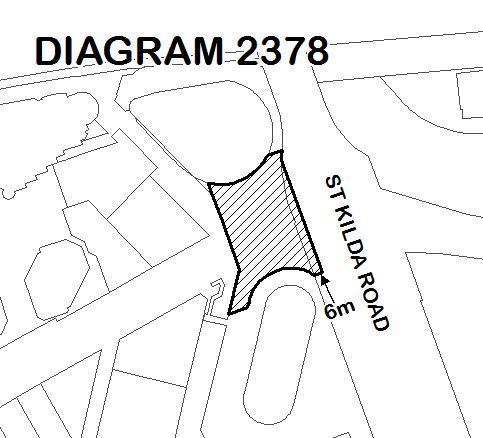


















Statement of Significance
What is significant?
How is it significant?
Why is it significant?
-
-
FORWARD SURGE - History
Arts Centre Lawn
Forward Surge is located on the Arts Centre Lawn. The lawn was included in the design of the Arts Centre partially to fulfil a condition imposed by the City of Melbourne. The design had placed Hamer Hall on the site of Snowden Park. The City of Melbourne permitted the loss of this park providing an equivalent "verdant space" was created to replace it. The Arts Centre Lawn does this. The lawn was also necessary to cover both part of the roof of the Arts Centre and the bridge over City Road, Sturt Street and Southgate Avenue.
Commissioning of Forward Surge
Forward Surge sits at the heart of the Victorian Arts Centre (VHR H1500). The complex was designed by the architect Roy Grounds from 1962 and the final building was completed in 1984 after his death. Forward Surge was installed on 22 March 1981. Roy Grounds chose Forward Surge from a 1:12 scale maquette included in King's second Australian solo exhibition, Inge King: Maquettes for Monumental Sculpture, held at the Chapman Powell Street Gallery, South Yarra on 2-14 April 1973. Powell Street Gallery director, David Chapman had arranged for the members of the Victorian Arts Centre Building Committee, including Roy Grounds, to visit the exhibition. As King later recalled, when Grounds saw the maquette for Forward Surge he said, 'I want this one.'
The maquette itself remained in the artist's possession until 2006, when she gifted it to the Arts Centre Melbourne (accession no. VAC2006-006.001). Before the full-sized sculpture could be fabricated, a second maquette had to be made to account for the wider bases that were needed to allow each element (a partial arch) to stand unsupported. The second maquette was later acquired by Dr and Mrs Bruce Munro and given by them to the Geelong Art Gallery in 1983 (accession no. 1983.76.a-e).
The final site for Forward Surge came to be seen by the artist as integral to the work. In the exhibition catalogue, the Forward Surge maquette was designated as a 'sculpture for open air environment.' While this was a very broad remit, in retrospect the location came to be seen by King as ideal. In large part, this is owing to the surrounding architecture: the curves of the steel sculpture echo the curves of Hamer Hall and the Theatres Building, while also contrasting with them in terms of material: black-painted steel versus concrete. The horizontal layout of the four sculptural elements / arches also acts as a counterpoint to the severe vertical thrust of the Arts Centre spire and the neighbouring high-rise apartment complexes. It took eight years for the work to be enlarged, fabricated and put into storage. During this time King paid repeated visits to the site. Shortly after the work was finally installed, on 23 March 1981, she wrote: 'I had clearly visualised Forward Surge in relation to its surroundings, but one cannot be absolutely sure until the work is installed. Seeing the sculpture finally in place on a beautiful sunny autumn day, the arches soaring into the sky, and linking the two buildings, spire and concert hall, was a wonderful experience.'
Manufacturing Forward Surge
The process of manufacturing Forward Surge was long and complex, entailing extensive meetings and correspondence with King, Grounds, the Arts Centre building committee, fabricators J.K. Fasham Pty Ltd and engineers Thermal Engineering. J.K. Fasham consigned the fabrication work to Thermal Engineering owing to the size of factory required to house the sculpture during fabrication. King chose her own structural engineer, Joe Borg, who was also a sub-contractor of J.K. Fasham. Borg made most of the computations for the enlargement of the curves. The artist's archive holds the original records of the protracted negotiations with all these people and companies. She said: '... with Forward Surge, I chose my own structural engineer. I had an engineering firm [Thermal Engineering] who would enlarge it but we needed a structural engineer... Grounds, Romberg and Boyd suggested that they would take over and I said no thankyou. Because I wanted to work with somebody who understood what I wanted; ... an insensitive engineer can suggest things that can ruin your work, and I knew I could talk to this man.'
The first sail was completed by June 1975 and removed by Mayne Nickless to the Public Works Department store in Port Melbourne. Fabrication was completed in 1976, and the fours sails were stored with the Public Works Department with only an undercoat. In her book on King, Judith Trimble described the internal armature and construction of Forward Surge: '... Like the hull of a ship, the sculpture has an internal structure. Steel arcs 5cm thick and braced by T and angle sections were aligned with paired steel trusses built to the same profile and positioned at intervals between them, the whole construction mounted upon a steel base. Horizontal steel beams linked these members and stabilised lateral movement. The inner curve was then clad with (precisely curved) 6 mm. mild steel plate cut down to long strips measuring 610 x 244 cm., as it was not possible to manage continuous lengths. The sheets were attached to the framework with fillet welds at intervals and welded edge to edge to create a smooth surface. Once the inner cladding was in place the forms became self-supporting, and props and braces were removed. ... The most difficult aspect of the job concerned welding the outer skin to the frame, especially in the narrowly tapered top of the curve. With welds ground and polished, the curves (now resembling great waves or sails) were stored; this was no small operation in itself. '
To install the work in 1981 police escorted four low-loaders from the Public Works Department store in Port Melbourne to St Kilda Road, which had to be partially closed off, on the morning of 22 March 1981. The four sails were attached to an underground concrete plinth installed on top of the immense concrete roof of the underground Arts Centre and bridge over the streets below. A team of men worked from 6 am to mid-afternoon to position the four steel elements on their concrete foundations The steel blades were painted black, in situ, using Dimet brand inorganic zinc silicate coating applied as a corrosion inhibitor followed by 'Dimet 25%' black semi-gloss paint.
Use of Forward Surge
Since its installation, Forward Surge has been the site of numerous community activities. These include markets, performances, meetings, weddings and other informal interactions such as family picnics. In 2006, with King's consent, Forward Surge was temporarily painted a teal blue colour as part of a Commonwealth Games project, `The Beach', in which the lawn next to Hamer Hall was transformed into a beach-like environment. King approved the project `because it means the sculpture has a life.' The sculpture was then painted black again. The blue paint layer is still visible under subsequent black layers.
Modernism
While European modernism came to Australia in 1910 and was visible in popular culture from the 1930s (for example in fashion and retail), it took until the late 1950s or 60s for it to become accepted in the arts including sculpture. Modernism aimed to reject the styles of the past and focus instead on innovation and experimentation in forms, materials and techniques in order to create artworks that better reflected modern society. Forward Surge is one of the most outstanding examples in Victoria of late modernist public sculpture. Its abstract style is typical of the way that modernist sculpture rejected traditional representations of the world.
History of Inge King and her work
Inge King (nee Neufeld) was born in 1915 in Berlin, where she initially trained as a wood carver in the studio of Hermann Nonnenmacher and later studied at the Vereingte Staatschulen für freie und angewandte Künste (Unified State Schools for Fine and Applied Art). This was one of the Weimar Republic's two great schools of art - the other being the Bauhaus. In 1939, she left for Britain where she studied on a scholarship at the Royal Academy, London, and at the Glasgow School of Art, gaining a diploma in sculpture in 1943. In the ensuing years, she gradually abandoned the academic figurative tradition in which she was trained in favour of an abstracted cubist form of carving, influenced by Jacob Epstein and Henry Moore. She showed work of this kind at her first solo exhibition, held at the London Gallery, 1949. She also travelled to France and the USA saying: 'My time in the United States was wonderful: it gave me new freedom; it was as though ballast had fallen off me - a European ballast.'
In 1950, she married the Australian painter and printmaker Grahame King in London and with him came to Australia in 1951, settling in Warrandyte. In Australia, she ceased carving and began constructing sculpture from sheet steel and copper wire, exhibiting these constructions and mobiles with her husband at the Peter Bray Gallery, Melbourne, 1952, and at the 1953 and 1957 Herald Outdoor Art Exhibitions in the Treasury Gardens. In 1959, she learnt to use an arc welder and thenceforth welded her work in steel, becoming one of the first sculptors in Australia - along with Clement Meadmore and Lenton Parr - to work primarily in that medium. She was also included that year in the significant Six Sculptors exhibition at the National Gallery of Victoria - the first ever showing of contemporary sculpture at the gallery. Along with her co-exhibitors from that show she would go on, in 1961, to co-found Centre 5, a group that agitated for the acceptance of abstract sculpture and for closer consultation with sculptors on the part of architects involved in the design of public works.
Her work of the 1960s featured heavily encrusted edges and joins, emphasising the artistic process of their construction. Relatively few works from this period were commissioned for public spaces in Victoria with Wodonga Fountain, 1972 (Wodonga Civic Centre), Shell Sculpture, 1965 (University of Ballarat) and Eurydice, 1965 (BHP) being among the few exceptions. In 1968, she began grinding steel to a smooth, polished finish, one example being Wall Sculpture I, 1968, (McClelland Gallery and Sculpture Park, Langwarrin). She was awarded her first two major commissions in Canberra and Brisbane between 1969 and 1973. These two commissions were of a scale that required King to work with engineers and fabricators - a process she considered enabled her to 'complete her training.'
From 1961 to 1988, Inge King's smaller works, which she assembled, welded and painted by hand in the studio, were nearly all in black-painted steel. Her first monumental black painted sculpture was Black Sun (1975) for which she won the Mildura purchase prize at the Mildura Sculpturescape. Forward Surge was the second of King's fabricated public works to make use of simple black-painted steel. Other major black painted steels commissions in Victoria include Sun Ribbon, 1980-82 (Melbourne University), and Grand Arch, 2001 (Art Gallery of Ballarat). King also produced sculptures made of steel painted in black and other colours such as Joie de Vivre, 1989 (ICI House); Shearwater, 1994 (ESSO Australia); Sentinel, 2000 (City of Manningham); Grand Arch, 2001 (Art Gallery of Ballarat); Rings of Saturn, 2005-06 (Heide Museum of Modern Art) and Red Rings, 2008, Eastlink trail.
King has held numerous solo exhibitions including those at Powell Street Gallery, 1969, 1973; Realities Gallery, 1977, 1980, 1985; Victor Mace Gallery (Brisbane), 1978; Coventry Gallery (Sydney), 1978; Bonython-Meadmore Gallery (Adelaide and Sydney), 1985, 1987, 1989; and the Australian Galleries, sixteen exhibitions since 1988. Major survey exhibitions have been held at Melbourne University, 1982; Deakin University, 1990; National Gallery of Victoria (NGV), 1992; Bendigo Art Gallery, 1995; ANU Drill Hall Gallery, 2002, and NGV, 2014.
King lectured in sculpture to trainee kindergarten teachers at the School of Early Childhood Studies at the University of Melbourne, 1961 to 1975, and taught sculpture at the Royal Melbourne Institute of Technology, 1976 to 1987. In recognition of her outstanding services to the arts in Australia she was created an Officer of the Order of Australia in 1984. More recently she was awarded the inaugural Dame Elisabeth Lifetime Achievement Award for Australian Sculpture, in October 2015. She is represented in all major public collections in Australia as well as in private collections throughout the country and in the UK, Europe and the USA.
References:
The nomination of Forward Surge was extensively copied for this assessment. It contained 69 references.Judith A. Trimble, 1996, Inge King: Sculptor, East Roseville, NSW: Craftsman House in association with G+B Arts International
Allom Lovell & Associates and Goad, Philip, 1995, Victorian Arts Centre Conservation Management Plan
James Gleeson, 1979, James Gleeson interviews Inge King., National Gallery of Australia, Canberra
https://nga.gov.au/Research/Gleeson/pdf/King_Inge.pdf
Andrew Saniga, 2012, Making Landscape Architecture in Australia, New South Books
Brenda Niall, 2002, The Boyds: A Family Biography, Melbourne University Publishing
Robin Grow, 2017, History of Snowden Park, Southbank Local News, http://www.southbanklocalnews.com.au/columns/detail/history_6134/
Amanda Bacon, 2008, Sculpture and Memorials, eMelbourne, School of Historical & Philosophical Studies, The University of Melbourne http://www.emelbourne.net.au/biogs/EM01342b.htm
City of Melbourne, 2008, John F Kennedy Memorial, eMelbourne, School of Historical & Philosophical Studies, The University of Melbourne http://www.emelbourne.net.au/biogs/EM02050b.htm
Rachel Roberts Communications, et al, 2009, Modernism http://www.australia.gov.au/about-australia/australian-story/modernism
The Charles O. Perry Studio, Charles O. Perry, http://www.charlesperry.com/sculpture/style/planar/
When Art Meets Architecture, 2014, Penelope Seidler AM talks about her extraordinary 50- year collaboration with her husband, Harry Seidler AC, Sydney Living Museums https://sydneylivingmuseums.com.au/stories/when-art-meets-architecture
East Link Sculpture Park booklet https://www.eastlink.com.au/images/documents/EastLink-sculpture-park-booklet-July-2017.pdf
Bauhaus, The Art Story http://www.theartstory.org/movement-bauhaus.htm
FORWARD SURGE - Assessment Against Criteria
Criterion
Forward Surge is of cultural, aesthetic and historical significance to the State of Victoria. It satisfies the following criteria for inclusion in the Victorian Heritage Register:
Criterion D
Importance in demonstrating the principal characteristics of a class of cultural places and objects.
Criterion E
Importance in exhibiting particular aesthetic characteristics.
Criterion F
Importance in demonstrating a high degree of creative or technical achievement at a particular period.
Criterion H
Special association with the life or works of a person, or group of persons, of importance in Victoria's history.
FORWARD SURGE - Permit Exemptions
General Exemptions:General exemptions apply to all places and objects included in the Victorian Heritage Register (VHR). General exemptions have been designed to allow everyday activities, maintenance and changes to your property, which don’t harm its cultural heritage significance, to proceed without the need to obtain approvals under the Heritage Act 2017.Places of worship: In some circumstances, you can alter a place of worship to accommodate religious practices without a permit, but you must notify the Executive Director of Heritage Victoria before you start the works or activities at least 20 business days before the works or activities are to commence.Subdivision/consolidation: Permit exemptions exist for some subdivisions and consolidations. If the subdivision or consolidation is in accordance with a planning permit granted under Part 4 of the Planning and Environment Act 1987 and the application for the planning permit was referred to the Executive Director of Heritage Victoria as a determining referral authority, a permit is not required.Specific exemptions may also apply to your registered place or object. If applicable, these are listed below. Specific exemptions are tailored to the conservation and management needs of an individual registered place or object and set out works and activities that are exempt from the requirements of a permit. Specific exemptions prevail if they conflict with general exemptions. Find out more about heritage permit exemptions here.Specific Exemptions:It should be noted that Permit Exemptions can be granted at the time of registration (s.49(3) of the Heritage Act 2017). Permit Exemptions can also be applied for and granted after registration (under under s.92 of the Heritage Act 2017.
General Condition 1All exempted alterations are to be planned and carried out in a manner which prevents damage to the fabric of the registered place or object.General Condition 2Should it become apparent during further inspection or the carrying out of works that original or previously hidden or inaccessible details of the place or object are revealed which relate to the significance of the place or object, then the exemption covering such works shall cease and Heritage Victoria shall be notified as soon as possible.General Condition 3All works should ideally be informed by Conservation Management Plans prepared for the place. The Executive Director is not bound by any Conservation Management Plan, and permits still must be obtained for works suggested in any Conservation Management Plan.General Condition 4Nothing in this determination prevents the Heritage Council from amending or rescinding all or any of the permit exemptions.General Condition 5Nothing in this determination exempts owners or their agents from the responsibility to seek relevant planning or building permits from the relevant responsible authority, where applicable.Specific Permit Exemptions-Touch-up painting of un-corroded areas of the sculpture only, using semi-gloss black paint, provided that preparation or painting does not remove large amounts of original paint.General Exemptions:-Maintenance and replacement of plumbing and electrical services near the sculpture providing that the original formation of the sculpture and its bluestone base remains unaltered, and does not have a detrimental impact on its cultural heritage significance.Public Safety and Security:-The erection of temporary security fencing, scaffolding, hoardings or surveillance systems to prevent unauthorised access or secure public safety which will not adversely affect significant fabric of the place provided that temporary structures are removed within 30 days of erection.-Emergency building stabilisation (including propping) necessary to secure safety where a site feature has been irreparably damaged or destabilised and represents a safety risk.Note: Urgent or emergency site works are to be undertaken by an appropriately qualified specialist such as a structural engineer, or other heritage professional.Signage and Site Interpretation:-No signage or interpretation may be fixed to Forward Surge.
-Signage and site interpretation activities provided the signs located and be of a suitable size so as not to obscure any views of or cause any damage to significant fabric of the place.-The erection of non-illuminated signage to ensure public safety or to assist in the interpretation of the heritage significance of the place or object and which will not adversely affect significant fabric including landscape features of the place or obstruct significant views of the sculpture.Landscape Exemptions-Works to pathways that are not part of the original design, and do not affect the cultural heritage significance of the sculpture and the Arts Centre Lawn.-Minor repairs and maintenance to hard landscape elements, structures, steps, paths, steps and gutters, drainage and irrigation systems, edging, fences and gates but not the bluestone paving surrounding Forward Surge.-The process of gardening, including mowing, hedge clipping, bedding displays, removal of dead shrubs and replanting the same species or cultivar, disease and weed control, and maintenance to care for existing plants.-The removal or pruning of dead or dangerous trees to maintain safety.-Subsurface works involving the installation, removal or replacement of watering and drainage systems in accordance with AS4970 and on the condition that works do not impact on the bluestone paving, concrete garden beds or underground concrete plinth.-Vegetation protection and management of possums and vermin.FORWARD SURGE - Permit Exemption Policy
PreambleThe purpose of the Permit Policy is to assist when considering or making decisions regarding works to a registered place. It is recommended that any proposed works be discussed with an officer of Heritage Victoria prior to making a permit application. Discussing proposed works will assist in answering questions the owner may have and aid any decisions regarding works to the place.
The extent of registration of Forward Surge in the Victorian Heritage Register affects the whole place shown on Diagram 2378 including the sculpture, land, landscape elements and other features. Under the Heritage Act 2017 a person must not remove or demolish, damage or despoil, develop or alter or excavate, relocate or disturb the position of any part of a registered place or object without approval. It is acknowledged, however, that alterations and other works may be required to keep places and objects in good repair and adapt them for use into the future.
If a person wishes to undertake works or activities in relation to a registered place or registered object, they must apply to the Executive Director, Heritage Victoria for a permit. The purpose of a permit is to enable appropriate change to a place and to effectively manage adverse impacts on the cultural heritage significance of a place as a consequence of change. If an owner is uncertain whether a heritage permit is required, it is recommended that Heritage Victoria be contacted.
Permits are required for anything which alters the place or object, unless a permit exemption is granted. Permit exemptions usually cover routine maintenance and upkeep issues faced by owners as well as minor works or works to the elements of the place or object that are not significant. They may include appropriate works that are specified in a conservation management plan. Permit exemptions can be granted at the time of registration (under s.49(3) of the Heritage Act 2017 or after registration (under s.92 of the Heritage Act 2017.
It should be noted that the addition of new buildings to the registered place, as well as alterations to the interior and exterior of existing buildings requires a permit, unless a specific permit exemption is granted.
Conservation management plansIt is recommended that a Conservation Management Plan is developed to manage the place in a manner which respects its cultural heritage significance.
Other approvalsPlease be aware that approval from other authorities (such as local government) may be required to undertake works.
Cultural heritage significanceOverview of significance
The cultural heritage significance of Forward Surge lies in both its appearance and location.
King intended Forward Surge to become the part of the Victorian Arts Centre complex that encouraged people to gather and relax in the shade of the sculpture, and on the lawn and visually orient themselves in the site. The sculpture is also highly visible to passing pedestrians. Forward Surge was intended to be visible from St Kilda Road, and one of Inge King's aims was to make a sculpture which could be appreciated from a moving car.
a) All of the buildings and features listed here are of primary cultural heritage significance in the context of the place. A permit is required for works or alterations. See Permit Exemptions section for specific permit exempt activities:
. Forward Surge sculpture, above and below ground
. Underground concrete plinth and fixings
. Arts Centre Lawn
b) Buildings and features that are listed here or not listed in a) or c) are deemed to have contributory cultural heritage significance to the place. A permit is required for most works or alterations. See Permit Exemptions section for specific permit exempt activities:
. Bluestone paving surrounding the sculpture
. Retaining wall of the Arts Centre lawn at St Kilda Road
. Raised concrete garden beds
. Narrow garden bed to the back of the site
. Original concrete bins
c) The following buildings and features are of no cultural heritage significance. Specific permit exemptions are provided for these items:
. Paths on the Arts Centre Lawn (where installed since implementation of the original design)
. Plants in the four concrete garden beds on the edges of the Arts Centre Lawn (replacements of the original plantings)
. Covered walkway
. Sculptures on the Arts Centre Lawn (where installed since implementation of the original design)
Specific Permit policiesAll the works recommended below (aside from monitoring) will require a permit or permit exemption.
Location policyThe sculpture should remain on its current, original site. Full public access to the sculpture should be maintained. Any works to the areas around the sculpture should ensure that the work remains fully accessible to the public. It is acceptable to put unobtrusive skateboard stops at the base of the 'waves' for public safety reasons.
The Arts Centre Lawn should be maintained as a grassy lawn. Consideration should be given to replacing the current palms (Livistona australis) with Eucalypts given that Inge King saw these trees as an important setting for her work. It is recognised that the original Spotted Gum trees (Corymbia maculata) may grow too large for the site, however a smaller species of Eucalyptus may be able to be used. No weed or vermin control chemicals are to be applied to the sculpture.
If there is ever a proposal to remove, replace or alter the walkway, any new structure should allow an uninterrupted view of Forward Surge from St Kilda Road.
Maintenance policyThe sculpture should be regularly maintained both above and below ground to stop corrosion of the metal and retain the sharp edges of the work. As part of a maintenance program, an engineer may need to document and monitor the structural condition of the whole work including the underground components and fastenings. The coatings should be regularly inspected by a conservator to ensure that they are functional both above and below ground and are not allowing water to enter the hollow sculpture.
A black semi-gloss paint should be used over corrosion inhibiting coatings in order to maintain the original appearance. It is recognised that the technology of painted coatings will change over time. As King was more concerned with the appearance than the materials of the coatings, different types of coatings and inhibitors may be acceptable. Where possible, the stable layers of original paint should be retained on the work as evidence of its history; provided that the edges of the original paint can be smoothed so as to maintain the overall smooth semi-gloss appearance of the sculpture. Where possible, the existing layers should be maintained. If the paint layers must be removed for preservation reasons, samples of the paint should be kept in the Arts Centre collection. Repeated sandblasting will damage the smooth surface of the steel and should not be allowed. Caustic or solvent based paint strippers are acceptable.
Inge King's daughters, Joanna Tanaka-King and Angela Hey may be able to provide further information about the artist's intent and aims.
-
-
-
-
-
MITRE TAVERN
 Victorian Heritage Register H0464
Victorian Heritage Register H0464 -
MELBOURNE SAVAGE CLUB
 Victorian Heritage Register H0025
Victorian Heritage Register H0025 -
GENERAL POST OFFICE
 Victorian Heritage Register H0903
Victorian Heritage Register H0903
-
1 Barkly Avenue
 Yarra City
Yarra City -
1 Clifton Street
 Yarra City
Yarra City -
1 Laura Place
 Yarra City
Yarra City
-
-







